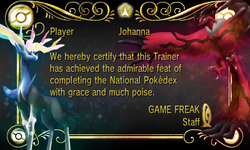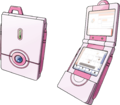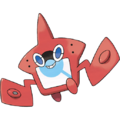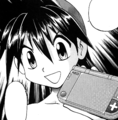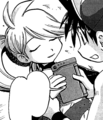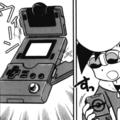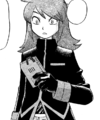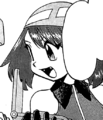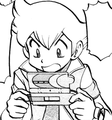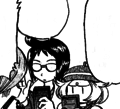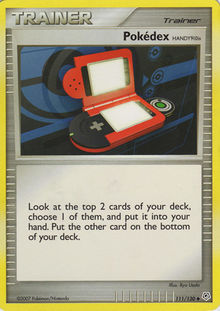Pokédex: Difference between revisions
Tiddlywinks (talk | contribs) m (→Generation VII: Please, do not assume. It's only been shown in Japanese) |
Tiddlywinks (talk | contribs) m (→Generation VII: This should be *removed* from here once we know the English, but until then, it's acceptable/the only option short of hiding this info) |
||
| Line 51: | Line 51: | ||
The [[Generation VII]] Pokédex consists of a device specially-designed to be inhabited by a {{p|Rotom}}, an innovation that gives the Pokédex its own personality and is intended as a new way for humans and Pokémon to communicate. In addition to a standard Pokédex function, the Rotom Pokédex includes a detailed map that can point out nearby locations of interest, and remind the player of the next objective based on recent conversations with NPCs. The Rotom Pokédex is a rare model even in the [[Alola]] region where it was created. | The [[Generation VII]] Pokédex consists of a device specially-designed to be inhabited by a {{p|Rotom}}, an innovation that gives the Pokédex its own personality and is intended as a new way for humans and Pokémon to communicate. In addition to a standard Pokédex function, the Rotom Pokédex includes a detailed map that can point out nearby locations of interest, and remind the player of the next objective based on recent conversations with NPCs. The Rotom Pokédex is a rare model even in the [[Alola]] region where it was created. | ||
Like the Kalos Pokédex, the Alola Pokédex is divided into several categories | Like the Kalos Pokédex, the Alola Pokédex is divided into several categories, the first of which is called (Japanese: '''メレメレずかん''' ''Melemele encyclopedia''). In addition to the number of Pokémon seen and owned, it also displays the total percentage of Pokédex completion. The player can also scan QR codes to add Pokémon they haven't encountered yet to the Pokédex, allowing them to check the Pokémon's location in Alola. | ||
===Search and order=== | ===Search and order=== | ||
Revision as of 16:08, 8 June 2016
- Zukan redirects here. For Japanese figures named after the Pokédex, see Pokémon Zukan figures.
- DEX redirects here. For Pokémon Trading Card Game expansion abbreviated as DEX, see Dark Explorers (TCG).
The Pokédex (Japanese: ポケモン図鑑 illustrated Pokémon encyclopedia) is a digital encyclopedia created by Professor Oak as an invaluable tool to Trainers in the Pokémon world. It gives information about all Pokémon in the world that are contained in its database, although it differs in how it acquires and presents information over the different media. However, they are also only given to a few Trainers at a time, generally to the ones that are felt to have exceptional potential and skill. There are different types of Pokédexes and each Pokédex is special to a specific region.
Pokédex entries typically describe a Pokémon in only two or three sentences. They may give background information on the habitat or activities of a Pokémon in the wild or other information on the Pokémon's history or anatomy. Pokédex entries also include height, weight, cry, footprint (prior to Generation VI), location, other forms, and a picture of the Pokémon.
Functions
The Pokédex is a handheld electronic encyclopedia device; one which is capable of recording and retaining information of the various Pokémon of the world. In order to accomplish Professor Oak's goal of a complete Pokémon database, the Pokédex is designed to find and record data on each Pokémon the Trainer meets. Pokémon are added to the Pokédex simply by encountering them in battle or, sometimes, by seeing a picture of the Pokémon. However, detailed entries are not recorded until the player catches the Pokémon, receives it as a prize/gift or acquires it in a trade.
Entries
The main feature of any Pokédex are the entries on each individual Pokémon, which provide details that would otherwise be unexplored in the games. Complete entries can only be seen for captured Pokémon, while uncaptured Pokémon only have limited information.
Generation I
In Generation I's Pokédex (model HANDY505), the entries are simple and each individual section can be accessed directly from the listing. The first, and main option—"Data"—includes an image of the Pokémon, its number, name, category, height, weight, and a short blurb. The second option—"Cry"—does not open a new screen; selecting it simply plays the Pokémon's cry. The last option—"Area"—displays the map, along with flashing indicators at each location where the selected Pokémon can be found; in cases where the Pokémon is not available in the wild, is only available once, or can only be found by fishing or in the Unknown Dungeon, the message "Area Unknown" will be displayed over the center of the map instead. Pokémon Yellow allows players to print entries using the Game Boy Printer.
Generation II
Generation II's Pokédex (model HANDY808) retains the same elements as its predecessor, while adding the Pokémon's footprint to the information and, like Yellow, allows players to print entries. Unlike Generation I, selecting a Pokémon displays the entry in a new screen from which the other sections can be selected. This became the norm for subsequent generations. International versions also have a "Page" button for long Pokédex entries (in Generation I player simply had to press A button instead); Japanese versions did not have multi-page Pokédex entries.
In these games, entries that would normally display "Area Unknown" on the map simply display an unmarked map.
Generation III
Generation III's Pokédex did not add anything to the main entry; however, Cry was given its own page, which displays the sound wave as it played. In addition, the Area section was changed to highlight locations instead of just marking them and can now display the locations of Pokémon obtainable by fishing. A Size section was added, which displays silhouettes of the Pokémon and the player character side by side. In Pokémon Ruby and Sapphire only, there is a Page button to switch between pages of multi-page Pokédex entries.
FireRed and LeafGreen's Pokédex (model HANDY909) displays entries in a much different format from Ruby, Sapphire and Emerald. It was the first Pokédex to actually display a Pokémon's type in its entry, as well as its menu sprite. However, the Cry visuals were removed. Entries for Kanto Pokémon were taken from Red/Green for FireRed and Red/Blue for LeafGreen. Johto Pokémon entries were taken from Silver for FireRed and Gold for LeafGreen. Additionally, in the international versions, it is the first Pokédex to show long Pokédex entries in full, instead of splitting them into two pages. This was carried over to later games, including Emerald.
Generation IV
Generation IV's Pokédex (model HANDY910) added numerous features, but of FireRed and LeafGreen's changes, it kept only type. Area now changes its highlight color depending on whether a Pokémon is found normally or exclusively using Honey, and the player can view the differences between morning, day and night, with the default being the current time. Cry's display returned, with a bar display in addition to the wave display, and the ability to modify the cry via Chorus/Pan, Reverb/Filter and Loop. Weight was added to the Size section, which puts the Pokémon and the player character on either side of a balance scale. A new Forms section allows players to see gender and form differences within species, but only for forms they have already seen. For a small list of Pokémon, if the player obtains a Pokémon from another country, they can change the language of that Pokémon's entry after meeting Meister. In Platinum, this function was expanded to all Pokémon, although it still requires Meister to update the Pokédex.
HeartGold and SoulSilver changed the formatting again, now displaying the list on the lower screen and the actual entry on the top screen. Cry's page was again removed. By selecting "view details", players can view Area, Size and Forms. Area no longer defaults to the current time or differentiated for Honey due to it no longer being a mechanic, Size now utilized both screens to display both Height and Weight at the same time, and Forms added a Compare option to see different forms side by side instead of having to scroll between them. Entries for Johto and Kanto Pokémon were taken from Gold for HeartGold and Silver for SoulSilver. Players can collect foreign Pokédex entries without the need to update their Pokédex. Also, while artwork shows a pink Pokédex for females, the in-game interface does not reflect this.
Generation V
The Generation V Pokédex is similar to the Pokédex from Pokémon Diamond, Pearl, and Platinum. It is displayed as a list on the right side of the lower screen with the selected Pokémon's sprite occupying the left side. Most of its functions are also similar to Generation IV's. Instead of showing the time of day that a Pokémon can be caught, as in Generation IV, the Pokédex shows the seasons in which it can be found. Areas in which the Pokémon can be found flash red, and touching an area will show the methods by which it can be caught (walking in tall grass, surfing, or fishing). The height and weight comparison feature has been removed, but a section showing form differences and a search feature are added by Cedric Juniper when the player visits Mistralton City. The form difference section will now show Shiny Pokémon as well as form differences. The last sprite selected will become the one displayed in the main entry. The ability to collect foreign Pokédex entries now only applies to the first 493 Pokémon, but the player can now also collect Korean Pokédex entries. The cry page has been added again as well.
In Black 2 and White 2, after defeating Cheren for the first time, Bianca will upgrade the player's Pokédex with the Habitat List, showing which Pokémon the player has already seen in the selected location, either normally, by finding in the water or via fishing rod (the latter two available later). If all Pokémon available in that place that are available via one of these three ways are seen (such as Purrloin and Patrat for tall grass on Route 19), the reference to the location in such way is marked with a Poké Ball-like stamp; after catching all Pokémon that are found via one of these three ways in current place, it gets marked with a colored Poké Ball-like stamp.
In all four games, extra Pokédex skins can also be downloaded through the Pokémon Global Link.
Generation VI
The Generation VI Pokédex is card-shaped and has a holographic center that is visible when the two ends are separated. It is also separated into three categories: Central Kalos, Coastal Kalos, and Mountain Kalos, and each category has a different icon in the Pokédex menu. The Coastal Pokédex is represented by a blue stripe on the left side of a pentagon, the Central Pokédex is represented by a white stripe down the middle of a pentagon, and the Mountain Pokédex is represented by a red stripe on the right side of a pentagon. The symbol for the National Pokédex is a Poké Ball.
If the player obtains a Pokémon that was created in Generation VI, the symbol in the Pokédex indicating it has been caught is a combination of the three Kalos Pokédex symbols: a pentagon with vertical blue, white, and red stripes. This resembles the flag of France, the region on which Kalos is based. If a Pokémon is transferred from a previous generation, the symbol will instead be a Poké Ball. The latter symbol can be updated to the former symbol if the player obtains a Pokémon of that species originating from Generation VI. If all Pokémon are obtained from Generation VI games, the Pokédex will be marked with a crown on the selection screen.
In the National Pokédex, there are color codes used to represent Pokémon introduced in each generation: red for Generation I, yellow for II, green for III, blue for IV, pink for V, and silver for VI. Like in Generation V, players may choose the default entry image for each Pokémon species, as long as they have seen that gender, coloration, or form of that species before. Like in previous games, acquiring Pokémon from foreign-language games will unlock the ability to view entries in those languages, so long as the player owns or has owned a Pokémon from that language. This time, all Pokémon entries can be obtained, allowing for both Generation V and VI entries for the first time.
Generation VII
The Generation VII Pokédex consists of a device specially-designed to be inhabited by a Rotom, an innovation that gives the Pokédex its own personality and is intended as a new way for humans and Pokémon to communicate. In addition to a standard Pokédex function, the Rotom Pokédex includes a detailed map that can point out nearby locations of interest, and remind the player of the next objective based on recent conversations with NPCs. The Rotom Pokédex is a rare model even in the Alola region where it was created.
Like the Kalos Pokédex, the Alola Pokédex is divided into several categories, the first of which is called (Japanese: メレメレずかん Melemele encyclopedia). In addition to the number of Pokémon seen and owned, it also displays the total percentage of Pokédex completion. The player can also scan QR codes to add Pokémon they haven't encountered yet to the Pokédex, allowing them to check the Pokémon's location in Alola.
Search and order

|
This section is incomplete. Please feel free to edit this section to add missing information and complete it. Reason: More information about the Pokédex search function and modes in B2W2 and XY |
The original Pokédex had no search function.
In Generation II, the ability to search for Pokémon by type was added, as well as the ability to sort by New Pokédex mode, Old Pokédex mode, A to Z mode and Unown Mode.
In Ruby and Sapphire, the search function was expanded to allow searches by name and color. Players were also given the option to order Pokémon by Heaviest, Lightest, Tallest, or Smallest. Two modes were available, Hoenn and National. National mode was unlocked via a trade with Kanto or Orre, or, in Emerald, defeating the Elite Four.
However, in FireRed and LeafGreen, the search function was dropped altogether, instead choosing to expand the sort functions by adding lists of Pokémon by type and habitat. Heaviest and Tallest orders were also removed. National Mode was unlocked by having obtained 60 Pokémon in the Pokédex, beating the Elite Four and completing the Sevii Island's sidequest.
Generation IV brought the Search function back, as well as Heaviest and Tallest orders. Habitat was dropped. Searches could now be conducted by Form, but not by Color. The two Pokédex modes were Sinnoh and National. National mode was unlocked by seeing every Pokémon in the Sinnoh Dex.
HeartGold and SoulSilver added the ability to search by Height and Weight (instead of simply sorting by them), and also allowed search by Area (Johto, Kanto, or Unknown). National Mode was added by talking with Professor Oak in the S.S. Aqua port in Olivine City after defeating the Elite Four.
In Generation V, the Pokédex for Pokémon Black and White Versions allows the player to search for Pokémon with the following criteria: Order (Number, A to Z, Heavy to Light, Light to Heavy, Tall to Short, and Short to Tall), Name (All letters of the alphabet), Type, Color, which was returned to the search after being dropped in Generation IV, and Form. Unlike in HeartGold and SoulSilver, the ability to search for Pokémon by area was dropped. By changing the Pokédex type, the player can search for Pokémon native to the Unova Region or from other regions, but in order to search for other Pokémon, the player must have first been obtained the National Pokédex upgrade from Cedric Juniper after the defeat of Team PlasmaBW/IrisB2W2. After obtaining the upgrade, the player can switch the Pokédex type from the National Pokédex to the Unova Pokédex at will by simply tapping "SELECT" in the lower portion of the touch screen or by pressing the SELECT button on the DS System.
In Generation VI, the ability to search for Pokémon that are not caught was added.
Only the currently set form of a Pokémon will be considered by the Pokédex when sorting and searching. All other forms will be ignored, and the form setting will not change to make the Pokémon match the search criteria. If the form is changed in the entry and the Pokémon either no longer matches the search criteria or belongs in a different place in the list, its entry will vanish or move according to its new form
Completion
Completing the Pokédex is a common goal of Trainers and carries with it much esteem due to its difficulty, which has gradually escalated due to the fact that around 100 new Pokémon are introduced with each new generation. However, this is mitigated to a degree by new features added to the games, such as Wi-Fi and the Global Trade System in Generation IV, and a less restrictive trading system (between PC boxes instead of only active teams) in Generation V. The exclusion of event Pokémon as a requirement for completing the Pokédex also makes it possible for people with no access to event distributions to complete the Pokédex.
The in-game rewards are usually a congratulations from the director's avatar and a diploma, usually one for completing the regional Pokédex and one for the National Pokédex. In Emerald, the player could choose from one of the Johto starter Pokémon for completing the Hoenn Dex. The completion of the Pokédex also usually allows the player to upgrade his/her Trainer Card. Also, in Pokémon Black and White, the diploma will appear on the shelf in the player's bedroom.
In Generations I to III, the completion of the regional Pokédex is tracked by how many Pokémon the player has caught. However, in Pokémon Diamond and Pearl and Platinum, the regional Pokédex is tracked simply by how many Pokémon the player has seen. In Pokémon HeartGold and SoulSilver, though, it again registers only Pokémon that have been caught. In Generation V, though Professor Juniper originally evaluates the player's regional Pokédex based on the Pokémon the player has seen, they may still only receive a diploma after having caught all regional Pokémon. Completion of the National Pokédex is always based only on the number of Pokémon caught.
In Pokémon Black and White 2, the system is revised to give the player more in-game recognition of their achievements. Once all the Pokémon in the Unova Pokédex have been seen, Professor Juniper presents the player a Permit, allowing access to the Nature Preserve. Once the player has caught all of the Pokémon in the Unova Pokédex, Professor Juniper will give the player an Oval Charm which increases the chances of finding Pokémon Eggs at the Pokémon Day Care. When the player completes the National Pokédex, Professor Juniper gives the player a Shiny Charm, which increases the chances of encountering and hatching Shiny Pokémon.
In Pokémon X and Y, Professor Sycamore will reward the player with an Oval Charm upon seeing all Pokémon in the Kalos Pokédex, except for Articuno, Zapdos, Moltres, and Mewtwo. Upon completing the National Pokédex, the player will receive a Shiny Charm from Sycamore.
In Omega Ruby and Alpha Sapphire, Professor Birch will reward the player with an Oval Charm upon seeing all Pokémon in the Hoenn Pokédex, except for Jirachi. Should the player complete the National Pokédex, Birch will also reward the player with a Shiny Charm. Also in Omega Ruby and Alpha Sapphire, the diplomas given by the director can be displayed in the player's Secret Base and can be viewed in the same way when obtaining it from the director. Other players visiting the secret base cannot see the full image on the diplomas, but instead will view it as an "impressive certificate".
Gallery of images
Interface

|
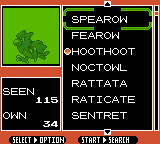
|

|
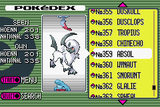
|

|
| Generation I | Generation II | RS | Emerald | FRLG |
|---|---|---|---|---|

|
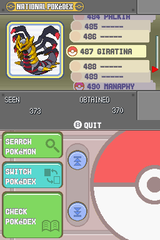
|
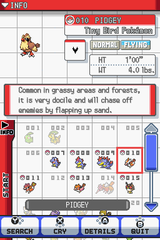
|
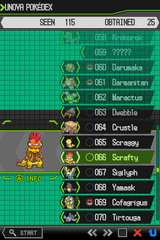
|
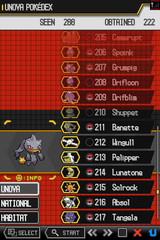
|
| DP | Platinum | HGSS | BW | B2W2 |
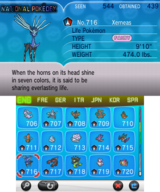
|
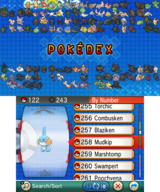
| |||
| XY | ORAS |
Artwork
The Kanto Pokédex in Pokémon Red and Green
The Kanto Pokédex in Generation I
The Johto Pokédex in Generation II
The Hoenn Pokédex in Generation III
The Sinnoh Pokédex in Pokémon Diamond and Pearl
The Sinnoh Pokédex in Pokémon Platinum
The male Johto Pokédex in Generation IV
The male and female Unova Pokédexes in Generation V
The Kalos Pokédex in Generation VI
The Alola Rotom Pokédex in Generation VII
In the anime
In the main series

When a young Sam was accidentally warped to a future of his own time, Ash explained to him how the Pokédex works, unknowingly giving him an idea. This is an example of a bootstrap paradox. This means the idea for the Pokédex came out of nowhere.
In Pokemon - I Choose You!, Ash receives his first Pokédex, apparently nicknamed "Dexter". Throughout the series, Ash uses it to either identify Pokémon he isn't familiar with, check a Pokémon's moves, or identify Pokémon on request. Occasionally, though, Ash will scan Pokémon he has already seen, likely to either refresh his memory or out of curiosity.
In Mystery at the Lighthouse, Brock tells Ash that a Pokémon Trainer can use their Pokédex to exchange their Pokémon.
In The Evolution Solution it was mentioned that the Pokédex entries were written by Professor Westwood V of the Seafoam Islands. Unlike the games, entries in the anime are pre-programmed into the database and do not require catching to give full information. In this way, they act more as a true encyclopedia than a data recording device. However, it should be noted that information relayed to the user may vary from time to time. This may happen even if the Pokédex remains unchanged in any way.
To look up information on a particular species, Trainers may simply point the Pokédex at an individual or manually enter it in. The Pokédex will then display a picture and read the entry out loud. In the Diamond & Pearl series, it was revealed that it can identify the Pokémon's level and learned moves, even for wild Pokémon. Apparently, a picture or video recording of sufficient quality can also be scanned for information. Attempting to identify a Pokémon not native to the region the Pokédex was designed for yields the message "no data" and a question mark in the display, as seen in The Journalist from Another Region when Ash scanned Kalos natives Helioptile and Gogoat with a Unova Pokédex.
In Kanto, Johto, and Unova, the Pokédex has a male voice, while in Hoenn, Sinnoh, and Kalos it has a female voice. The upgraded Pokédex Ash and Serena received at the end of All Eyes on the Future! also has a male voice in the Japanese version.
Like in the games, the Pokédex has gone through various designs. This includes its shape and way of opening, display, as well as the aforementioned voice. The Unova Pokédex redesign in the anime is significant, as it shows all the viewing angles from the Pokémon, with the exception of the back.
Trainers without the luxury of a Pokédex may have access to other means of finding information. Some use high-tech computers, like Giovanni in The Thief That Keeps On Thieving! or Shingo in Wired for Battle!. In several episodes, James uses a deck of cards, which slightly resemble TCG cards.
Pokédex entries
|
Voice actors
| ||||||||||||||||||||||||||||||||||||||||||||
In Pokémon Origins
The Kanto Pokédex appeared during the Pokémon Origins mini-series, where they served the same purpose as in the original Pokémon Red and Blue games. They recorded basic info of any Pokémon encountered, and detailed info of any Pokémon caught. Much like in the games, one was given to both Red and Blue by Professor Oak. By the end of the last episode of the mini-series, Red had managed to capture all 150 Generation I Pokémon, excluding only Mew. Blue's Pokédex was later crushed when his Blastoise accidentally crashed onto it while he was battling Mewtwo in the Cerulean Cave.
Besides listing all the caught Pokémon in numerical order, the Pokédex was also able to sort the recorded Pokémon data by other factors, such as the type, as seen when Professor Oak tried to identify the Pokémon Blue had fought by going through the list of Psychic-type Pokémon in Red's Pokédex.
Gallery of images
Ash's original Pokédex
Ash's Sinnoh Pokédex scanning Dawn's Piplup
Dawn's Sinnoh Pokédex
The Unova Pokédex
Scanning Snivy on the Unova Pokédex
Kanto Pokédex in Pokémon Origins
Scanning Dedenne on the Kalos Pokédex
In the manga
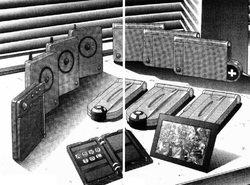
In the Pokémon Adventures manga
In Pokémon Adventures, only a select group of people have Pokédexes and they are highly respected as a result. The Pokédexes come in groups of three or four per region, and are generally given out along with a starter Pokémon from the region's Professor. Each Pokédex has a holder registration system, meaning when it is assigned, the holder must register his or her name and fingerprints, which means each of the Pokédexes is only allowed to have one rightful owner. However, it is possible to transfer data from one Pokédex to an upgraded version, leaving the Pokédex that had its data transferred with no rightful owner, and thus, the Pokédex would be able to be reassigned to a new owner. It is shown that when the three Pokédexes from the same region are put together, a Pokédex will make a beeping sound as a signal to indicate that another Pokédex is nearby. This only works when held by their rightful owner, as seen in Gimme Shellder. This signal seems to apply for all models of the Pokédex, and the Sinnoh Pokédex holder trio refers to it as the "morning sound" (Japanese: 朝の音), due to it being used to wake the trio up every morning while they were together
Much as in the anime, the Pokédex in Pokémon Adventures displays the known moves of an individual Pokémon, as well as its current health, its cry, its current moves, and can even track them. Unlike in the anime, the Pokédex entries are usually taken directly from the games and as such contains readable text rather than having the information spoken out loud. The Pikachu interaction feature from Pokémon Yellow was added to Red's Pokédex, allowing him to see its mood (though he never is seen making much use of it, as Yellow was in possession of his Pokédex for most of the Yellow arc, and could tell Pika's mood on her own anyway). The Pokédex's function takes over much of the control the games give to the player, being able to prevent a Pokémon's evolution, whereas Trainers without a Pokédex have no choice in the matter. As seen in Wanted: Pikachu!, the Pokédex can discover where a Pokémon was first met by its Trainer, much as the feature added in Pokémon Crystal allows one to view a Pokémon's origin. In addition to these functions, the Pokédex is able to record and project hologram images and can serve as a portable transporter with the assistance of a Pokégear and Mobile Adapter cable.
In the FireRed & LeafGreen arc, Professor Oak asks Red, Blue, and Green to return their Pokédexes to him, so that he could upgrade them to National Dex. Though in the process, they get stolen by Orm and used by Carr to create a "black Pokédex" (Japanese: 黒い図鑑). Later in the story, the new Pokédexes are received by the trio, and Red's old one is given to Yellow, while Blue and Green's old Pokédexes are destroyed by Deoxys. In the HeartGold & SoulSilver arc, the Johto Pokédex holders get new Pokédexes as well, though it is unknown what happened to their original Pokédexes. In addition, the Pokédex formerly held by Cheren was later given back to Cedric Juniper, and eventually destroyed. The third Kalos Pokédex was found by Malva along with Fennekin, but it was destroyed after she deemed it worthless.
There are currently 19 Pokédexes in operation, coming in nine models based on region and mode.
While most of the holders have red Pokédexes, the Pokédex can also come in a variety of colors. Crystal, White, and Whi-two have pink Pokédexes, while Diamond and Pearl carry a blue Pokédex and an orange Pokédex respectively.
Gallery of images
Red's Pokédex
Blue's Pokédex
Green's Pokédex
Yellow's Pokédex, formerly Red's
Gold's orange-red Pokédex
Silver's orange-red Pokédex
Crystal's pink-white Pokédex
Ruby's first Pokédex
Sapphire's Pokédex
Emerald's first Pokédex
Wally's Pokédex, officially Emerald's
Black's Pokédex
White's pink Pokédex, formerly Bianca's
X's Pokédex
Team Rocket's black Pokédex
In The Electric Tale of Pikachu manga
In the manga series The Electric Tale of Pikachu, Pokémon Trainers receive their Pokédexes when their application to become a Pokémon Trainer is accepted. A Pokédex contains information on a Pokémon's moves and abilities, as well as general information (such as how some Pokémon, like Pikachu, dislike Poké Balls) and the ability to tell if a Pokémon has critically low HP. In addition, all Pokédexes contain a copy of the Trainer's license.
Updated versions of the Pokédex are released from time to time: in Clefairy Tale, Professor Oak gives Ash a beta version of the latest model of the Pokédex.
In the TCG
This listing is of cards mentioning or featuring the Pokédex in the Pokémon Trading Card Game. The Hoenn region's model did not receive a TCG card, and the Generation I and Generation II Pokédexes, which featured model numbers on the Japanese cards (HANDY505 and HANDY808 respectively), did not show these model numbers on the English card. The Generation V Pokédex has no model number even in the Japanese card; it also has the same effect and English name as the Generation I Pokédex. Every card has allowed the player to look at a certain number of cards from the top of their deck and then either arrange them as they like, or in the case of Pokédex HANDY910is, choose one to put in their hand.
| Related cards Cards listed with a blue background are only legal to use in the current Expanded format. Cards listed with a green background are legal to use in both the current Standard and Expanded formats. | |||||||
|---|---|---|---|---|---|---|---|
| Card | Type | English Expansion |
Rarity | # | Japanese Expansion |
Rarity | # |
| Pokédex | I | Base Set | 87/102 | Expansion Pack | |||
| Base Set 2 | 115/130 | ||||||
| Nivi City Gym | |||||||
| Guren Town Gym | |||||||
| Black & White | 98/114 | Beginning Set | 036/037 | ||||
| BW-P Promotional cards | 023/BW-P | ||||||
| New Pokédex | T | Neo Genesis | 95/111 | Gold, Silver, to a New World... | |||
| Pokémon Web | 016/048 | ||||||
| PokéDex HANDY909 | T | EX FireRed & LeafGreen | 96/112 | Flight of Legends | 077/082 | ||
| Pokédex HANDY910is | T | Diamond & Pearl | 111/130 | Space-Time Creation | |||
| Torterra Half Deck | |||||||
| Infernape Half Deck | |||||||
| Empoleon Half Deck | |||||||
| Raichu Half Deck | |||||||
| Bastiodon the Defender | |||||||
| Rampardos the Attacker | |||||||
| Platinum | 114/127 | Dialga Half Deck | 011/013 | ||||
| Giratina Half Deck | 012/013 | ||||||
| Palkia Half Deck | 012/013 | ||||||
| Garchomp Half Deck | 012/016 | ||||||
| Charizard Half Deck | 012/016 | ||||||
Trivia
- For Two Degrees of Separation!, Professor Oak's Big Pokémon Encyclopedia is about the Pokédex. He writes this senryū about it: 「こまったら ひらいてみよう ポケモンずかん」 "When troubled, let's open the Pokédex."
- Most of the Pokédexes appear similar to one of Nintendo's handhelds.
- Though the original Kanto Pokédex doesn't resemble any Nintendo handheld devices, the Generation III Kanto Pokédex resembles a Game Boy Advance SP.
- The Johto Pokédex resembles a Game Boy Color, whilst the Generation IV Johto Pokédex is in similar appearance to a Nintendo DSi.
- Both versions of the Hoenn Pokédex appear similar to the Game Boy Advance.
- The Sinnoh Pokédex resembles a Nintendo DS Lite.
- However, the Generation V Unova Pokédex does not look like the next handheld, the Nintendo 3DS (although it was not released at the time of Black and White), but rather a slide phone.
- The Generation VI Kalos Pokédex also seems to have basis on a tablet, or possibly the Wii U GamePad and/or the Nintendo 2DS.
- In most canons, the Pokédex is evidently encased in material that is invulnerable to almost anything within reason. It has been soaked in water and (in the anime) electrocuted and exposed to high-temperature flames, all with no ill effect. It is also voice-sensitive. There are some limitations to its ability; certain circumstances can prevent the Pokédex from accurately identifying its target:
- A Pokédex which has not received a National Mode upgrade will not display any information on Pokémon not usually found in its home region, even if those Pokémon have been caught, and if captured, its number will be listed as "???" in the summary screen.
- Similarly, Gary's Pokédex failed to identify Mewtwo at the Viridian Gym, displaying only static interference.
- All six of Ash's Pokédexes have been red, as are all of the Pokédexes for male player characters in the games, while other characters have had other colors. May had a yellow one in Kanto, Paul has a dark blue Pokédex, Dawn has a pink Pokédex, Rhyanna has an ice blue Pokédex, Narissa has an orange Pokédex, and Mamie has a lavender Pokédex.
- The only Pokédex Ash has never owned is the Pokédex introduced in HeartGold and SoulSilver, but such has been owned by Lyra and Khoury.
- The Kanto regional Pokédex and the Sinnoh regional Pokédex (Diamond and Pearl) have 151 members, the smallest of all regional Pokédexes. The largest regional Pokédex is the Kalos regional Pokédex, with 454 members.
- The Pokédex models of Generations I and II rounded the weights of all Pokémon to full pounds except for Gastly and Haunter, despite the Japanese games' use of tenths of kilograms since the start. From Generation III onward, all weights have been given to the nearest tenth of a pound.
- The Pokédex lost several buttons with every new model, due to various upgrades: Kanto's first model has twenty-two buttons; Johto's original model has five; Kanto's second model, both of Hoenn's models, and Sinnoh's only have three; and Johto's second model, both of Unova's models, and the Kalos model all apparently have no buttons whatsoever, solely using the touch-screen interface.
- Numerous toy Pokédexes have been manufactured by companies like Tiger Electronics and Jakks Pacific.
- In HeartGold and SoulSilver, the Pokégear's map displays the hat of Ethan's icon in its updated Generation IV design; however, the Pokédex map displays the icon's hat in its Generation II design.
- The Pokédex entries in Pokémon Black and White Versions for Pokémon not native to Unova are the same as those from Pokémon Platinum Version.
Names
| ||||||||||||||||||||||||||||||||||||||||||||||||||
| |||||||

|
This item article is part of Project ItemDex, a Bulbapedia project that aims to write comprehensive articles on all items. |



